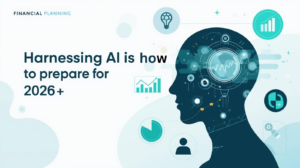In today’s fast-changing world of financial planning, artificial intelligence (AI) is no longer just a buzzword. It is becoming a vital resource for individuals and financial advisors alike. With the end of 2025 approaching, now is the time to look back on the past year while preparing for what lies ahead in 2026. This post will explore how AI enhances financial planning and provide a practical guide to create a year-end reflection worksheet. This tool can help ensure a successful and goal-oriented 2026.
The Role of AI in Financial Planning
AI is changing the game in financial planning by offering data-driven insights and automating repetitive tasks. For instance, tools like robo-advisors can analyze your portfolio and suggest adjustments based on current market conditions. According to a study by Deloitte, firms that incorporate AI-driven insights have experienced up to a 30% increase in client satisfaction. As we head into 2026, expect to see deeper integration of AI in financial planning strategies. Advisors will use AI not only for efficiency but also to create customized financial plans that align with individual goals and risk profiles.
Benefits of AI in Financial Planning
- Enhanced Data Analysis: AI systems can sift through millions of data points in seconds to provide accurate predictions and risk assessments. For example, a financial tool may predict the likelihood of a stock’s performance based on economic indicators, helping you make smarter investment choices.
- Personalization: AI can adapt financial advice to fit your unique circumstances. This might involve suggesting specific savings plans based on your income level or even alerting you if you’re spending outside your set budget, increasing the relevance and effectiveness of the guidance you receive.
- Cost Efficiency: By taking over mundane tasks, AI frees up time for financial advisors to concentrate on complex client needs. Studies revealed that practices using AI have reduced operational costs by approximately 20%, enabling them to offer more competitive pricing.
- Improved Decision-Making: AI tools provide predictive analytics that can guide clients through complex market trends. For instance, a well-timed investment recommendation based on AI analytics can yield returns that increase by 12% compared to traditional methods.
Creating a 2025 End-of-Year Reflection Worksheet
As we prepare for 2026, an end-of-year reflection worksheet can serve as a valuable tool. Here’s a simple guide to creating one:
Step 1: Set Clear Objectives
Start by defining what you aim to achieve in 2026. Do you want to save for a vacation, invest in real estate, or enhance your retirement funds? Clearly stating your goals will streamline your reflection process.
Step 2: Review Your Financial Goals
Look back on the financial goals set at the start of 2025. Did you accomplish them? If not, identify the challenges you faced. According to a Fidelity survey, 40% of individuals reported not meeting their financial goals due to unexpected expenses. Recognizing obstacles can highlight areas for growth.
Step 3: Analyze Your Spending Habits
Utilize AI-driven budgeting apps to evaluate your spending trends over the past year. Discover where you may have overspent and identify opportunities to cut costs. For example, if you spent more than 15% of your budget on dining out, consider setting a specific limit for 2026.
Step 4: Evaluate Investment Performance
If you invested in stocks or other assets, review their performance. Did your portfolio grow by at least 10%, or did it fluctuate significantly? Use AI tools to assess market trends and adjust your strategy accordingly, aiming for an investment return that aligns with your risk tolerance.
Step 5: Identify Lessons Learned
Reflect on key takeaways from 2025. What decisions positively impacted your finances, and what mistakes can you learn from? A study indicated that 60% of successful investors attributed their achievements to learning from past errors, highlighting the importance of this step.
Step 6: Set Actionable Steps for 2026
Based on your reflections, outline specific steps for 2026. Whether it’s modifying your budget, diversifying investments, or consulting a professional advisor, having a defined action plan will enhance your chances of achieving your goals.
The Future of AI in Financial Planning
In 2026, the presence of AI in financial planning will likely broaden even further. We might see advancements in machine learning that improve predictive analytics and personalization. As more people become adept at using technology, demand for AI-driven solutions will burgeon. Financial advisors who embrace these tools will stand out, offering efficient, tailored services that can greatly enhance client outcomes.
Individuals who implement AI tools in their financial strategies can expect to navigate the complexities of their finances with greater ease. For instance, users of AI budgeting apps have reported feeling 30% more in control of their financial lives.
Final Thoughts
As the close of 2025 approaches, reflecting on your financial experiences is essential. By utilizing AI in financial planning, you can gain critical insights and make informed decisions to align with your aspirations. Creating a reflection worksheet for 2025 will help you evaluate your journey and prepare effectively for a thriving 2026.
Leverage the potential of AI in your financial planning efforts, and take proactive steps towards achieving your financial goals in the coming year. With the right approach, you can confidently navigate the financial landscape and make choices that lead to long-term success.



About The Author: Lynn Demmons
Lynn Demmons, speaker, author, mentor, consultant and financial rebound couch, partners with women and businesses helping each discover the purpose, priorities, and motivation to achieve generational wealth. Her simple yet practical, effective systems empower clients to grow and focus on outcomes not incomes. As a result, her clients achieve the best financial life for their purposes. Lynn's philosophy is "be generous with what you have- no matter how big or small; results will follow."
More posts by Lynn Demmons